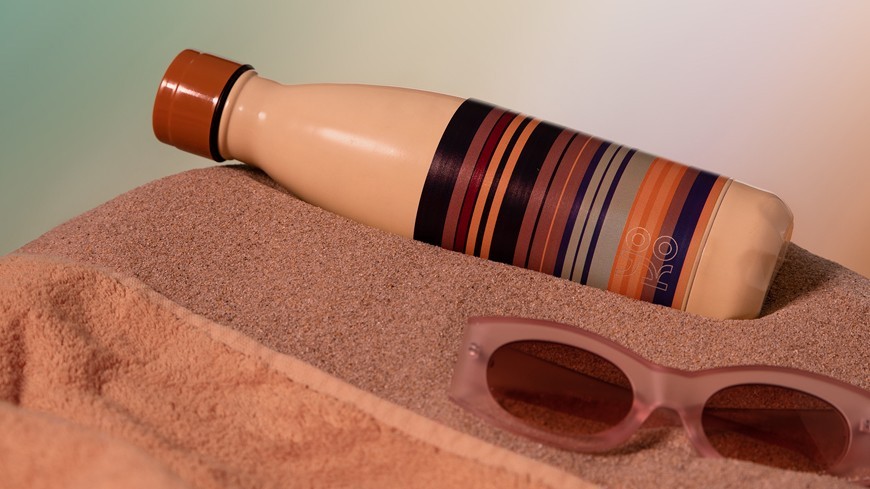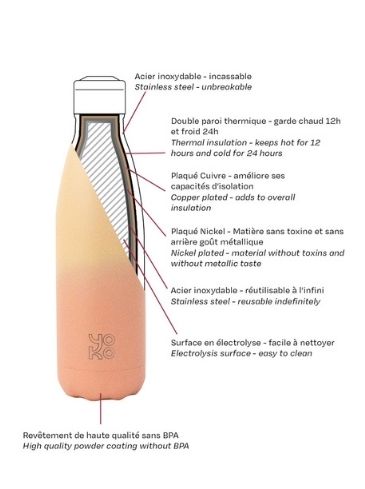Stainless steel bottles : advantages and disadvantages

Concern for the environment has led to a welcome return to sustainable, rather than disposable, materials. This is why the stainless steel bottle, whose name is shortened to stainless steel bottle, has been back in force in our shelves for a few years now. With everything to please, its success was immediate and its popularity continues to grow.
The durability of stainless steel
Let's start by looking at the raw material of the stainless steel bottle: stainless steel. This alloy made of iron, carbon, nickel and chromium is prized for its high resistance to corrosion and oxidation that produce rust.
However, it is important to take care of your gourd. You must avoid dents that alter its shell and not leave it too long in an aggressive environment: salt water, acidic foods, corrosive detergents, etc.
Your stainless steel gourd must also be protected from contact with chlorine, sulfuric acid or hydrochloric acid.
On the other hand, stainless steel is not affected by water or any other cold or hot beverage. It is stable, which ensures that your water bottle will last a long time and that you will be able to use it again and again.
The advantages and disadvantages of the stainless steel bottle
The maintenance of a stainless steel bottle : Simple, but essential
The longevity of your stainless steel bottle depends on the care you give it. It is elementary, but essential. For the outside, a sponge wipe is enough.
The inside is simply rinsed. For a more thorough cleaning, you can use a brush (a brush with a long handle) or put your stainless steel bottle in the dishwasher. However, make sure that the coating is compatible with this type of washing. Remember to clean the stopper and its screw thread.
Cleaning with white vinegar or bicarbonate from time to time will help you remove lime deposits and residues from other drinks.
Leave your stainless steel bottle open if you are not using it for a long time, to avoid the development of mould.

Hygiene of a stainless steel bottle
Stainless steel is everywhere, starting in the hospital world where hygiene standards are drastic. Surgical tools are mainly made of stainless steel for their resistance to rust, as well as for their smooth surface which does not offer any grip to dirt and allows an exhaustive cleaning.
Stainless steel is also used in the food industry and catering, whether for production, storage, transportation or for service in the kitchen.
The robustness of a stainless steel bottle
Stainless steel does not break under the effect of an impact. However, it can be deformed and dented.
To avoid this inconvenience, you can wrap it in a neoprene cover. There are also insulated shoulder cases that protect against both shock and temperature fluctuations.
Neutral taste of stainless steel
An essential characteristic of stainless steel is that its taste is perfectly neutral and will not affect the flavors of your contents, whether it is pure water, flavored water, hot drinks or fruit juice.
On the other hand, its smooth structure does not retain odors, which ensures that your stainless steel bottle will not retain odors from one content to another.
No chemicals in stainless steel
Stainless steel does not contain Bisphenol A (BPA), a harmful compound used in the manufacture of plastics and resins that make up plastic water bottles.
Unlike aluminum bottles, stainless steel does not need a coating. It contains no chemicals that could dissolve in your drink.
The isothermal capabilities of stainless steel
As soon as you are on the move, you will appreciate a double-walled insulated stainless steel bottle that preserves the temperature of your drink, cold or hot, between 12 and 24 hours.
The stainless steel insulated bottle is a little heavier, but reliable.
The ecological interest of a stainless steel bottle
Stainless steel is completely recyclable, but what counts most is that you keep your bottle for a very long time. Being recyclable is a quality, but it is not enough to preserve the environment. We must never neglect the energy spent to recycle materials: collection, transport, treatment, storage, transport to the future manufacturer...
The real ecological gesture is to take care of your water bottle so that you don't have to buy another one.
The choice of capacities and designs
The 1L stainless steel bottle is the classic model, but it is available in many other capacities. For a child's stainless steel bottle, for example, you will probably choose a smaller capacity.
As for the designs, the possibilities are unlimited, so please yourself with the patterns and colors you like!











